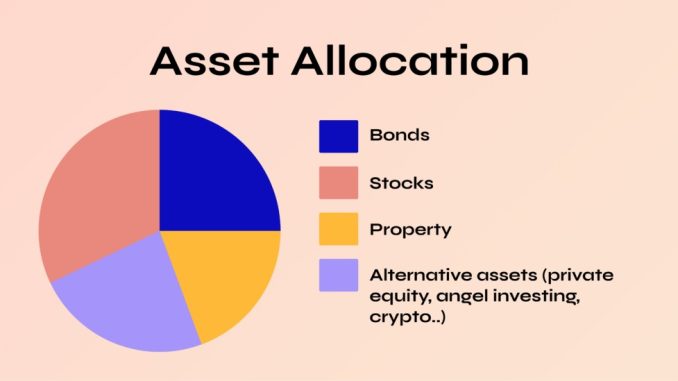
The world of investment can often appear daunting, filled with complex jargon and a dizzying array of options. Yet, at its core, one principle stands out as fundamental to long-term success and risk management: asset allocation. Far from being a mere buzzword, asset allocation is a strategic investment approach that involves dividing an investment portfolio among different asset categories, such as stocks, bonds, and cash equivalents. It’s the critical first step before picking individual investments, acting as the architect’s blueprint for your financial future, tailored to your unique financial goals, time horizon, and tolerance for risk. Understanding its basics is paramount for any aspiring or seasoned investor, including those navigating the burgeoning financial landscape of Myanmar.
At its essence, asset allocation is built upon the understanding that different asset classes perform differently under various market conditions. When one asset class is thriving, another might be lagging. The primary objective is not to pick individual winning stocks, but to create a diversified portfolio that aims to maximize returns for a given level of risk, or conversely, minimize risk for a given level of return. This diversification across asset classes helps to mitigate the impact of volatility. If your entire portfolio is heavily weighted in one type of asset, a downturn in that specific market segment could have a catastrophic effect on your wealth. By spreading your investments, the poor performance of one asset class can be offset by the stronger performance of another, creating a smoother, more predictable investment journey.
The three primary asset classes typically considered in basic asset allocation are **equities (stocks), fixed income (bonds), and cash equivalents**. Each comes with its own risk and return characteristics. **Stocks**, or equities, represent ownership shares in a company. They generally offer the highest potential for long-term growth and capital appreciation. However, they also carry the highest level of risk, as their value can fluctuate significantly in the short term due to market sentiment, company performance, and economic cycles. For an investor in Myanmar, this might mean investing in publicly traded companies on the Yangon Stock Exchange (YSX) or considering international equity markets through various investment vehicles. While stocks can experience sharp downturns, their historical performance over extended periods often demonstrates superior returns, making them crucial for long-term wealth building, especially for younger investors with a longer time horizon.
**Fixed income investments**, primarily bonds, represent loans made to governments or corporations. When you buy a bond, you are essentially lending money to the issuer in exchange for regular interest payments and the return of your principal at maturity. Bonds are generally considered less volatile and less risky than stocks, providing a more stable income stream. They often serve as a ballast in a portfolio, offering stability during stock market downturns. However, their potential returns are typically lower than those of stocks. For investors in Myanmar, government bonds or corporate bonds issued by reputable companies could be part of their fixed income allocation. Bonds are particularly attractive for investors nearing retirement or those with a lower risk tolerance, as they prioritize capital preservation and consistent income over aggressive growth.
**Cash equivalents** include assets like savings accounts, money market accounts, and certificates of deposit (CDs). These are the most liquid and least risky assets, offering capital preservation and ready accessibility. Their returns are generally the lowest among the three asset classes, often barely keeping pace with inflation. While they don’t contribute significantly to wealth growth, cash equivalents are essential for an emergency fund, for short-term financial goals, or as a temporary holding place for funds awaiting investment opportunities. For instance, having a portion of your portfolio in a highly liquid savings account with a reliable bank in Yangon ensures you have immediate access to funds without needing to sell potentially declining investments.
The crucial determinant in deciding the right allocation among these asset classes is an investor’s **risk tolerance and time horizon**. Generally, younger investors with a longer time horizon (e.g., 20-30 years until retirement) can afford to take on more risk, thus allocating a larger portion of their portfolio to stocks, which have greater growth potential over the long run. As an investor approaches retirement or has a shorter time horizon for a specific goal, their risk tolerance typically decreases, necessitating a shift towards a more conservative allocation with a higher proportion of bonds and cash to preserve accumulated capital. For example, a 30-year-old professional in Myanmar might have an allocation of 80% stocks, 20% bonds, while a 55-year-old nearing retirement might opt for 40% stocks, 50% bonds, and 10% cash.
It’s also important to understand that asset allocation is not a “set it and forget it” strategy. Market fluctuations will inevitably cause your portfolio’s original allocation to drift. Therefore, **periodic rebalancing** is essential. This involves adjusting your portfolio back to your target asset allocation by selling off assets that have performed well and buying more of those that have underperformed. Rebalancing helps to maintain your desired risk level and can also force you to “buy low and sell high” in a disciplined manner.
In conclusion, asset allocation is the strategic cornerstone of successful investing. It recognizes that different asset classes offer unique risk-reward profiles and that true portfolio resilience comes from intelligent diversification across these classes. By understanding your personal financial goals, time horizon, and risk tolerance, and by regularly reviewing and rebalancing your portfolio, you can create an investment strategy that is robust, adaptable, and aligned with your aspirations, providing a clear path towards achieving your long-term financial objectives in the complex yet opportunity-rich world of investment.